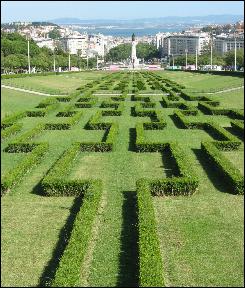Victoria here, writing from Lisbon, where it is sunny and delightfully breezy. Above, the statue of Marquis de Pombal, at the foot of Parque Eduardo VII, named for the British King who visited here in 1903 to confirm the continuing alliance of Portugal and the United Kindom. Below, the view from the top of the park, looking down toward the statue, the broad tree-lined boulevard beyond it, to the River Tagus.
The Marquis de Pombal (1699-1782) was a distinguished statesman who provided strong leadership after the terrible earthquake and tsunami that devastated Lisbon November 1, 1755. He also abolished slavery in Portugal and her colonies, reorganized the army and navy, and improved the administration of colonial Brazil, among other accomplishments. His statue overlooks the Avenida da Liberdade, a broad boulevard with gardens and restaurants and lined by banks, hotels and smart shops.
The sidewalks are paved with small stones, often in patterns, as along the boulevard.
We stopped for luncheon at one and sat outside under the shade of huge plane trees and beside a large palm. One of the cafe’s specialities was a smoothie called Splash. Delicious.
Since we are to leave on our cruise tomorrow, we went down to the River Tagus to see the port. Across the street was the Military Museum honoring the centuries of Portuguese domination of large areas of the world Brazil, Mozambique, Goa, and Macao, to name a few. It is often pointed out here that Portuguese is the third most widely spoken European language in the world.
Inside the museum were displays of events from the discovery of sea routes to India by Vasco DaGama through the Napoleonic invasions to World Wars I and II. Below the uniform of Portuguese troops fighting with Lord Wellington early in the Peninsular Wars.
Finally a few pictures which fail adequately to show the beauty of the blue/purple blooming trees found all over town. I think they are Jacaranda trees, a beautiful shade that reminds me of periwinkle blue. Stunning!!

What gorgeous photos! Thanks for taking us along on the trip and who knew there was so much to connect Regency England and Portugal. LOVE those trees. They remind me of my wisteria when it is in full bloom.
how lovely, Vicky!!!